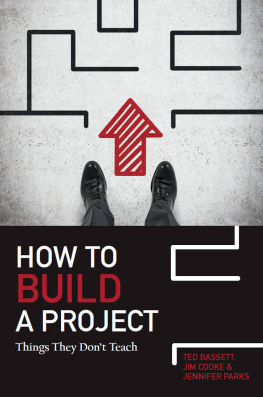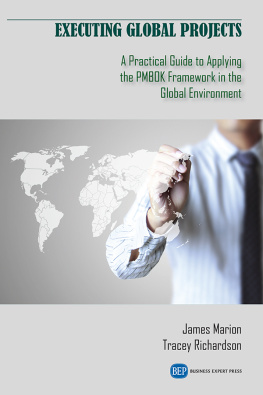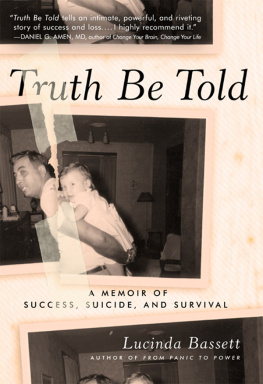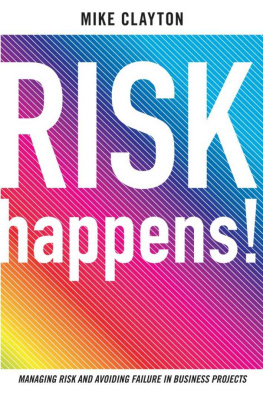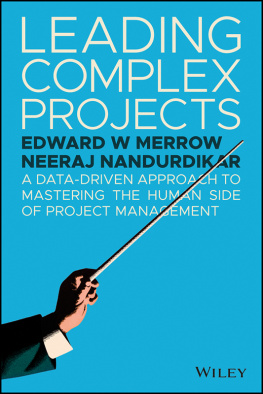HOW TO BUILD A PROJECT
Things They Dont Teach
Copyright 2015 Mr. Ted H. Bassett, Jim Cooke, and Jennifer Parks
All rights reserved, including the right to reproduce this book or portions thereof in any form whatsoever.
Designed by Jennifer Roberts
Published in Canada.
1 2 3 4 5 6 7 8 9 1 0
ISBN: 1505380847
ISBN 13: 9781505380842
HOW TO BUILD A PROJECT
Things They Dont Teach
TED BASSETT, JIM COOKE, AND JENNIFER PARKS
DISCLAIMER
Characters and events in this book are all based on history. However, to bring a scene or person to life, some dialogue was made up, care being taken to offer a realistic representation of people and events. They are opinion.
In some cases, Jennifer Parks created scenes between Jim and Ted from her imagination, based on her interview time with them, in an effort to link the stories and lessons into a coherent narrative.
All characterizations of people and event details derive from the memories and perspectives of Ted Bassett and Jim Cooke. All facts around major political and business events were verified by public record during the writing process. Some names of individuals have been changed out of respect for their privacy.
ACKNOWLEDGMENTS
This book would not exist without the incredible support and encouragement of many people. Thank you, first of all, to Anita, for the original sparks of inspiration for penning these stories and adventures. Your undying strength, courage and pure joy for life are the true lights which guided this project. To all of our amazing families, Mona and Paul Bassett; Ashley Fulks and The Parks; Beryl Cooke & clan: Jim, Jenn and I never could have done it without your love, patience and input along the way. We are especially grateful for the Cookes incredible hospitality during our time together in Kelowna. Thank you to my mentor and friend, John Somers: you set the highest example for the kind of leader I wanted to be. To Gord Clark, thank you for your valuable contributions on the Russian and Canadian mine sampling process. To Jenn Roberts, for the fine cover design and book layout. And to Veronica Rossos, for your professional legal counsel. Finally, thank you to our editors and layout staff at CreateSpace.com for guiding us through the publishing process. It takes a great team to build a successful project. Im proud of what weve all created together.
~ Ted Bassett
CONTENTS
Overview
Ted Bassett has worked his share of projectsfrom a remote open-pit operation in post-Communist Kyrgyzstan to Busang, Indonesias scandal-racked Bre-X gold mine. And hes seen it all.
After witnessing slip-ups that ruined reputations, senseless risk taking that resulted in lost lives and limbs, and project managers whod fallen in love with their projects, only for their brains to fall out, the project vet wondered, how the heck did I get here?
His question was part existential, part tongue-in-cheek. After more than forty years working globally scaled projects in the mining and metals industry, Ted knew well that no sterile textbook full of contrived artificial examples and oversimplified theories could have prepared him for this down-and-dirty cutthroat world. It took some hard-won street smarts, sweat, stamina, and sacrifice to rise to the top of his gamethis engineer and married father of two who joked that he couldnt stand on a ladder and screw in a lightbulb.
But Ted Bassett knew where to find the guy who could, which made him invaluable. He also knew that projects were built by teams, not individuals, and so led his teams accordingly.
Ted credits his successes to the exceptional people he had the good fortuneand good senseto work with along the way and to his great mentor, John Somers, a realist, who told him: You might as well aim high, cause youre gonna hit low enough, anyway. But even more than his successes, Ted credits his failures for teaching him how to lead and inspire others toward high performance, integrity, loyalty, and teamwork. After decades, all of this got Ted thinking, Now, how can I give back?
What advice or guidance could he offer new engineers to help them not only survive but succeed in the muddy snake-filled trenches of project work? Little did Ted realize, the answer to this question lay in his heart.
Years back, his daughter, Anita, had been relentless in urging him to pen his many globe-trotting adventures, which have taken him from soaring above perilous summits to tasting bittersweet triumph to wading in dirt, defeat, and even death. How to Build a Project: Things They Dont Teach is that proffered book. Written in a dramatic narrative style, it follows Ted through the peaks and pitfalls of a demanding career in project management, as the concurrent story of Anitas heart-wrenching battle with cancer unfolds.
The reader travels with Ted, family, and friends from the mountains of northern Kyrgyzstan (where Teds illusions of safety are shattered during a crisis that leaves Anita wondering if she still has a dad), to a tense Saskatchewan court Discovery Room where Ted must face his own demons, on to the frigid North, full of glistening Diavik diamonds, where success and boredom meet, and then Down Under on two of the biggest and most hair-pulling projects of Ted Bassetts epic career.
One day, Ted might be halfway around the world, in a hard hat and work boots, juggling sticky foreign politics with schedule changes, budget constraints, new drill data, and the emergent needs of a three-hundred-person work crew. The next day, he might be power-suited up in a Toronto boardroom for a high-level corporate strategy meeting to solve the mind-bending puzzle of how to save billions during a fiscal crunch while expanding output at one of the planets largest copper and uranium mines.
Teds cousin-in-law, Jim Cooke, is another key participant in this book. A fellow engineer who worked in the oil and gas industry, Jim built his career upon vision and leadership. Early on, hed identified an attitude in the corporate culture that allowed engineers to sink or swim. Finding this unacceptable, Jim made it his top priority and passion to offer this preparatory training or support. Whereas Ted was hired to think and take mining projects from their inception through to their completion, Jim worked with companies and trained their project managers how to think, setting them up for success.
In the summer of 2012, Ted and Jim met for a week in Kelowna, British Columbia, and together, with freelance journalist and creative writer, Jennifer Parks, they fleshed out a concept for this book. After much storytelling and discussion of project principles and philosophies, they came to the conclusion that, despite their different career paths, when you rise above the pieces that go into a project, the principles of sound management are the same, no matter the industry.
This book is the result of that week together.
Says Ted: Every project starts with a plan and requires blueprints, a budget, a time line, a team, and a leader. Any textbook can teach you that stuff. But only a great manager can give a project vision by inspiring commitment, innovation, leadership, and excellence. These are what you need to draw on, he concludes, when reality inevitably swoops in and hijacks your perfect plan.
Im hopeful that How to Build a Project will give engineers and managers some entertaining late-night reading that still qualifies as work, along with some practical tools and insights for those who are seeking an edge in their profession, says Ted.
Note: At the end of each chapter, you will find a list of principles that apply to the stories and examples found within that chapter and a comprehensive list at the end of the book for easy reference.
Next page
